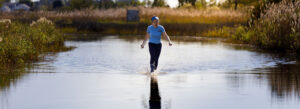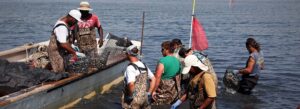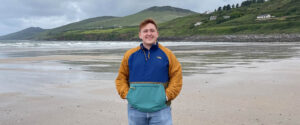Imagine a farmer that couldn’t control the soil in their fields. That’s the reality for oyster hatcheries, who rely on water from the Chesapeake Bay as their “soil” to grow oyster larvae.
A new type of recirculating aquaculture system — RAS for short — will help oyster hatcheries gain control over water quality. Traditionally, hatcheries located on the shoreline pump nearby water to use in their tanks of oyster larvae. Rather than constantly treating new water from the Bay, a RAS setup allows hatcheries to treat and re-use the same water.
Harmful algal blooms, too-warm water, torrential rain, or other pollutants in the water can mean sickness or even death for larval oysters in hatcheries. These water quality issues will likely persist or worsen from future climate change. A system that cleans and reuses hatchery water eliminates the need to constantly filter water from the Bay flowing into the hatchery.
Recirculating systems aren’t a new idea in aquaculture — finfish farms have used them for decades. But up until now, these systems haven’t been developed for shellfish hatcheries.
Troubled waters
Most of the time, hatcheries don’t know exactly what has caused water quality to decline, which can make it hard to identify the best way to filter the water when the oysters do get sick or die, said Mike Congrove, hatchery operator and owner at Oyster Seed Holdings.
Out in the Bay, adult oysters can close off, stop feeding, and survive off of their energy reserves for a few days when water quality is poor. Oyster hatcheries set out to breed hardy, healthy oysters, but baby oysters are especially vulnerable to poor water quality, since they must constantly feed to grow and survive. Hatcheries have to keep these oysters healthy in the first few weeks of life as the oysters prepare to settle, and continue the rest of their lives out in the water beyond the hatchery.
The first line of defense in hatcheries is mechanical filtration — straining larger particles out of the water. But that won’t remove biological toxins or adjust the water chemistry. Those require more complicated filtering methods, like sterilizing the water or using special resins to filter out pollutants. Hatcheries can use activated carbon to combat harmful algal blooms, but bouts of poor water quality aren’t usually predictable.
“Unfortunately, when we’re trying to institute those types of filtration, we kind of throw a bunch of stuff at the wall and see what sticks,” Congrove said.
Recirculating systems take the guesswork out of water quality and can also save hatcheries the costs of special filtration needed for water from the Bay. Also, the recirculating water is already at the right temperature for oysters. This will cut down a hatchery’s heating bill, since the hatchery doesn’t have to constantly heat incoming water.
Closing the loop to open new potential
Just like in a fish tank or aquarium, reusing the same water without filtering it allows harmful chemicals to build up over time. To eliminate toxins like ammonia in the RAS, the water runs through a biofilter to eliminate harmful chemicals after the water leaves the tanks where the oysters grow. The biofilter, backed up by UV sterilization, can also eliminate harmful bacteria like vibrio, which causes oyster disease.
A team of researchers at the Virginia Institute of Marine Science and Virginia Tech Seafood Agricultural Research and Extension Center (VSAREC) designed and tested a recirculating aquaculture system (RAS) for oyster hatcheries through Sea Grant funding in 2019.
First, the team tested two small-scale systems to see whether they could filter out toxins and allow young oysters to grow. Dick Snyder, director of the VIMS Eastern Shore Lab, said the long-term goals of the project, once the system is tested, will help hatcheries make their own systems for commercial use.
“We’re trying to design a protocol — these are the parts you need, this is where you buy them from, this is what they cost, this is how you put it together, this is what you do. You buy this media, you put it in there, you fill it up with water, you dose it with this dose,” Snyder said.
Through a Virginia Fishery Resource Grant, Congrove built and tested an RAS system in his hatchery. During the spring and summer, Congrove will compare oyster larvae from the main hatchery to see how well the RAS system works at a small scale. If successful, the system can be scaled up to produce more oyster larvae.
“This system was designed to be a 10 percent version of what we do here in our hatchery,” Congrove said. “We’re hoping to have a production capacity of about 10 million larvae per week out of this system.”
After completing construction on the FRG-funded system, Congrove has run over a dozen larvae cultures though the system and while performance is not yet up to that of the regular system, he is optimistic about the future.
“We haven’t gotten the system working just right yet, but we are learning a lot that will help us continue to dial in the RAS operating procedures,” he said.
The ‘recipe’ for healthy water? Microbe soup
Behind the system’s biofilter is a team of microbes breaking down toxins and harmful chemicals in the water. But developing this microbial community was no small task. Most helpful bacteria grow slowly compared to harmful bacteria. Cultivating this helpful bacterial community — collectively known as the microbiome — can take up to a month or longer if the system is starting from scratch.
Once the microbes have built up their numbers, they develop a biofilm — a gel-like substance that builds up on plastic beads in the water. At this point, the helpful microbes are established, and hatcheries can add dirty water for the biofilter to clean.
While the goal of the RAS is to stabilize the key microbes living in community, the microbiome can and will can change due to environmental influences. Avoiding shocks to the system, like a sudden lack of oxygen, helps keep the community as steady as possible.
“Anything you put into a system affects the microbiome,” explained VSAREC Director Michael Schwarz. “Anything you put into a fish tank, anything you put into an oyster tank affects the microbiome.”
So far, the microbiome in the RAS has kept harmful chemicals like ammonia from building up in the tank — and has reduced the levels of harmful bacteria by four orders of magnitude. That allows hatcheries to keep their tanks clean without adding antibiotics or other chemicals to clean the water.
Collaborating with a hatchery to test the system allows the researchers to see how the microbiome can change in a dynamic hatchery setting. The hatchery can also run more trials with the system, with a larger sample size than the researchers testing the smaller-scale system.
A living filter for hatchery water
To clean the water, the biofilter system offers several layers of filtration. First, the water goes through a heterotrophic filter, where helpful microbes eat and remove harmful bacteria like vibrio.
Next, the water goes through one tank with autotrophic microbes that break down oyster waste and other organic buildup in the system. Finally, a protein skimmer removes any remaining biological remnants left in the water before it is ready to be re-entered into the oyster tanks.
“Some of these bacteria are converting the ammonia to nitrite, and then we don’t have toxicity in the system,” explained Reza Ovissipour, a microbiome researcher at VSAREC. “Some of the bacteria are controlling the water chemistry and making sure it is suitable for growing fish or oysters. Some of them, they can control the pathogenic bacteria. That’s why we call them a microbial consortium — Different types of bacteria are working together at the same time.”
Every two days, hatchery operators swap out the water out in the young larvae culture tanks, while older larvae culture tanks receive newly cleaned water continuously. This process repeats for about two weeks, until the oysters transition to the next phase in their lifecycle and are harvested from the tanks.
Expanding the system
To build on the promising results so far, the next step will be learning the makeup of the microbial community that has made this RAS successful. A NOAA Fisheries Saltonstall-Kennedy Grant will give the researchers an opportunity to study the microbiome in more detail. The researchers will analyze the water from successful test-runs at the hatchery to find out what microbes are present in the bioreactor.
The biofilms include bacteria, protozoans, amoeba, ciliates, flagellates, and protozoans all living in community. Identifying the key microbial players is the first step to understanding their role on the team.
“I think the most challenging part is going to be understanding the microbial community, and the different bacteria’s role in deactivating the vibrio,” Ovissipour said.
Once the team understands more about the microbial community, they can adjust the “recipe” or apply it to other types of aquaculture systems.
Recirculating systems take the guesswork out of water quality and can also save hatcheries the costs of special filtration needed for water from the Bay.
Takeaways:
- Recirculating aquaculture systems give hatcheries more control over the water in their hatcheries and protect the oysters from sudden dips in water quality.
- Researchers and a hatchery teamed up to design and test a commercially viable RAS for hatcheries through a Virginia Fisheries Resource Grant.
- A complex community of bacteria and other microbes filters the water, removes toxic buildup and harmful bacteria, and cleans the water before it returns to the oyster tanks.
- Next, the researchers will analyze the makeup of the RAS microbial community to understand the filter’s success and apply it to other systems.
Photos and Video by Aileen Devlin | Virginia Sea Grant
Published August 5, 2021





